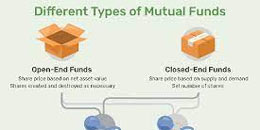
Are you new to investing and unsure what differentiates a closed-end fund from an open-end one? With the hundreds of investment options available, it can be overwhelming to determine which investment is best for your goals. Feel free to if you're feeling uncertain about closed-end and open-end funds.
In this blog post, we'll dive into the differences between these two types of investments so that you can make an informed decision for your portfolio. So grab a cup of coffee and get ready to learn about each style – including advantages, risks, and strategies – so that you fully understand all aspects when planning for your financial future.
Closed-end funds (CEFs) and open-end funds (OEFs) are mutual funds, but they have some key differences.

A closed-end fund is a pooled investment vehicle, typically only offered at certain times during the year. It has a fixed pool of assets and limited shares for trading on an open market.
Unlike traditional mutual funds that can issue new shares as demand increases, CEFs are issued in an initial public offering (IPO) and are bought and sold on the open market.
In contrast, an open-end fund is a type of mutual fund that allows investors to buy or sell shares of the fund at any time based on its current net asset value (NAV).
Open-end funds typically have more liquidity than closed-end funds because they can issue new shares to meet demand.
CEFs are created when a group of investors pools their money to buy shares in a company that will use the money to purchase securities.
A professional money manager manages the fund and decides which securities to buy and sell. CEFs are traded on the open market but don't follow the same pricing rules as other stocks or mutual funds.
Since there is no new issuance of shares, the price of a closed-end fund can fall below its NAV or rise above it, depending on demand.
OEFs are created when an investor buys shares directly from the fund company, which then uses the cash to purchase securities.

Unlike closed-end funds, open-end funds are priced according to their NAV and can have multiple share classes with different fees and risk levels.
OEFs typically offer more liquidity than CEFs because a professional money manager actively manages them, and the fund company can issue new shares as demand increases.
Now that you understand the differences between CEFs and OEFs, it's time to decide which is right for you. Consider your financial goals, risk tolerance, and timeline when making this decision.
Consult a qualified financial advisor if you have further questions about either option. With the proper guidance and research, you can make an informed decision about which type of fund is right for you.
The biggest difference between CEFs and OEFs is that CEFs have a limited number of shares that can be bought or sold, while OEFs do not.
CEFs typically have a fixed number of shares and cannot issue new shares to meet demand. Demand for the fund can cause its price to go above or below its NAV.
In contrast, open-end funds are priced according to their NAV and can issue additional shares as necessary.
The other key difference between CEFs and OEFs is the level of risk. Since closed-end funds have limited shares, they can be more volatile than open-end funds.
On the other hand, open-end funds are actively managed by professional money managers who make decisions about which securities to buy or sell, which can reduce some of the risks.
When deciding which type of fund is right for you, it's important to consider your individual financial goals, risk tolerance, and timeline. A qualified financial advisor can help you decide which option is best for your portfolio.
With the proper guidance and research, you can ensure that you make the right choice for your financial future.
This means that the price of a CEF share is more volatile than an OEF share since it's more challenging to sell them on the open market.
This is true. Since closed-end funds have limited shares, they can be more volatile than open-end funds. This means that a CEF share's price can move significantly in response to market conditions.
In contrast, the price of an OEF share is typically more stable because there are usually multiple classes available, and the fund company can issue additional shares as necessary.
Furthermore, since CEFs do not typically follow the same pricing rules as other stocks or mutual funds, they can sometimes trade at a discount or premium to their NAV, depending on demand.
This means that investors need to be aware of possible fluctuations in price and act accordingly. On the other hand, OEFs are typically priced according to their NAV and, therefore, less subject to price volatility.
Ultimately, the type of fund that is best for you depends on your financial goals, risk tolerance, and timeline. If you have further questions about either option, consult a qualified financial advisor who can help you make an informed decision.
With the proper guidance and research, you can make an informed decision about which type of fund is right for you.
Both types of funds offer tax advantages and diversification benefits, so it's important to consider your specific needs before investing.
Yes, both types of funds offer tax advantages and diversification benefits. CEFs are structured as a corporation, which means that investors can receive a dividend payment from the fund each year. This income is taxed lower than other forms of investment income.
Additionally, since closed-end funds can invest in multiple securities, they offer investors the potential for greater diversification than other types of investments.
On the other hand, OEFs are generally structured as a mutual fund, which provides investors access to professional money managers who can actively select and manage securities within the fund. This type of passive management strategy can help reduce risk while providing investors with an easy way to gain diversification across multiple asset classes.
Additionally, since OEFs are tax-deferred investments, investors can often defer paying taxes on the income generated from their investment until it is received.
When deciding which type of fund is right for you, it's important to consider your individual financial goals, risk tolerance, and timeline. A qualified financial advisor can help you decide which option is best for your portfolio. With the proper guidance and research, you can ensure that you make the right choice for your financial future.
FAQs
Which type of fund is better for long-term investing?
The type of fund that is best for long-term investing depends on your individual financial goals and risk tolerance. Closed-end funds can offer investors a higher potential for return and access to multiple asset classes, but they may be subject to more price volatility than open-end funds.
On the other hand, open-end funds are typically more accessible and offer a lower level of volatility, making them better suited for long-term investments.
Ultimately, consulting with a qualified financial advisor is important to determine the best option for your unique situation.
What are the benefits and drawbacks of closed-end funds?
Closed-end funds (CEFs) offer investors a higher potential for return than open-end funds and access to multiple asset classes.
Additionally, the fund's structure allows for greater diversification of investments and tax advantages.
However, it is important to note that CEFs have more price volatility than other types of funds, meaning that the fund may trade at a discount or premium to its net asset value.
Additionally, CEFs are less liquid than open-end funds and may require larger investments to purchase shares.
How do I choose the right type of fund for my investment goals?
Choosing the right type of fund for your investment goals can be complicated. Ultimately, the type of fund that is best for you depends on your financial goals, risk tolerance, and timeline.
If you have further questions about either option, consult a qualified financial advisor who can help you make an informed decision.
With the proper guidance and research, you can ensure that you make the right choice for your financial future.
Conclusion
Deciding whether to invest in a closed-end or an open-end fund boils down to what you are looking for in an investment. Open-end funds offer more liquidity, while closed-end funds may provide higher returns.
Understanding the difference between these two types of funds is important before making any investment decisions. We hope this article has shed some light on the key differences between closed-end and open-end funds.











